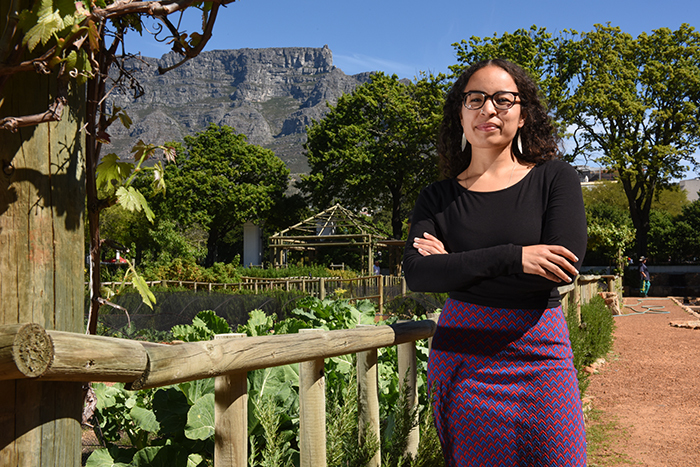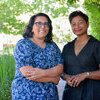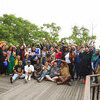Heritage tour spotlights city's little-known slave history
21 September 2016 | Story by Newsroom
When arts graduate Amie Soudien visited the Western Cape Archives and Records Service in Roeland Street to trace her family history, she was frustrated by the patchy record of her genealogy. Her surviving grandparent, her paternal grandfather, could recall very little about his own grandparents and ancestors.
Soudien, an Institute for Creative Arts (ICA) National Fellow in the Faculty of Humanities, has been interested in memory and place almost since she can remember. Her parents were very involved with the District Six Museum and her father, Crain Soudien (former deputy vice-chancellor at UCT), has been a museum trustee for many years.
Her art practice expresses historically engaged work and questions of representation. Her fourth-year exhibition at Michaelis School of Fine Art in 2013 was focused on heritage and origins, both her own and of those who lived and worked in the city for many generations.
“It's very difficult for people of colour in Cape Town to trace their heritage, especially if they are descended from slaves. I was interested in the very complex nature of the Capetonian past and trying to understand where my family fits in this historical narrative, before apartheid and colonialism.”
Soudien imagined other ways of telling this history and approaching the “well-worn stories” and dominant narratives about early life in the Cape.
“I approached this by looking at my family and trying to understand how history is recorded. I was very interested in the holes in the archives around the identity of people of colour, and the very stark differences in how the histories of different strata of society were recorded.”
Her public installation with the ICA at the end of her final year saw her trace the names of her ancestors in the sand in the alley between parliament and the Slave Lodge on Adderley Street, a “different and personal” way of recording them in history.
Slaves and free burghers
Soudien's Heritage Day tour explores a much earlier history. Her tour narrative concerns one woman, Ansla van Bengalen, who upended many notions about slaves.
It's widely taught that in 1652 the Dutch East India Company (VOC) established a halfway station and trading base at the Cape under the command of Jan van Riebeeck. What's less taught is the story of the slaves like Van Bengalen, many of whom came from India, Indonesia, Madagascar, Guinea and Angola.
The Cape Colony was a slave society for over 170 years, but little remains of their history and lived experiences.
“We don't know much about what their lives were like or even the kinds of experiences they had while living in the Cape,” Soudien says.
Van Bengalen was kidnapped by slave traders in the Ganges delta region of Bengal and arrived in the Cape aboard the Amersfoort. VOC Commander Pieter Kemp, a free burgher from Batavia, sold Van Bengalen and her children to Jan van Riebeeck and his wife, Maria. Van Riebeeck sold her to Abraham Gabbema in 1662 and he liberated her in 1666.
After gaining her freedom, Van Bengalen asked for a plot of land in the Heerestraat and the deed was signed by Commander of the Cape, Cornelis van Quaelbergen. The former slave became the first woman in the Cape to be granted land in her own name. In 1668 'Maai Ansiela', as she became known, was baptised as a Christian (a necessary part of being freed from enslavement) at the castle and became part of the greater VOC society.
She married Arnoldus Willemsz Basson and became a prosperous and respected member of the early Cape society, even after Basson died in 1698. Van Bengalen lived well into her 70s – she died in 1720 having amassed a handsome estate, which had grown under her careful management. She eventually owned livestock, property in Table Bay, a small farm in the Drakenstein and the farm Kronendal in Hout Bay. Her daughter, Anna de Koning, became the mistress of Groot Constantia.
Van Bengalen and Basson's six children became the forebears of thousands of South Africans, making her one of the stammoeders, or matriarchs, of South African society.
“Ansla van Bengalen's story is one of agency,” said Soudien, “something we don't hear very often. It upends ideas about slavery and what happened to many free blacks.”
“It's important to understand that there were many resourceful and resilient people who came to the Cape under the direst circumstances and somehow managed to turn their fortunes around.”
The Cape's paradoxical history
Soudien will be situating the Heritage Day tour narrative in the context of the time that Van Bengalen lived in the Cape to provide a social context and not “mere anecdote” about her life.
Her initial research was supported by Carine Zaayman, a lecturer in New Media Studies at Michaelis, as well as Dr Siona O'Connell, director at the Centre for Curating the Archive, and other academics. She's planning to film the tour for a website and to supplement this with texts uncovered during her research.
Soudien recently returned from two years at the School of the Art Institute of Chicago to a city still grappling with its “multi-layered and dense” history, which remains a conundrum to many Capetonians.
“If you ask people where they come from, it's quite loaded for many people. Cape Town has always been a paradox and it has been since the first European settlement. Those dynamics are still very much evident [in the city]. I hope the tours will generate a richer understanding of our city, unearthing some of the things that have been hidden for a long time.
But hers is not a touristic endeavour. In many ways, Soudien says that presenting her research and narrative story will “push up against the very big emphasis on tourism in Cape Town and the way the city is often geared to tourists and not to the people who have lived and worked in the city for many generations”.
“I see this as [an initiative] for Capetonians … There is so much we don't know and slavery has a way of erasing culture and so many things.”
Story Helen Swingler. Photo Michael Hammond.
 This work is licensed under a Creative Commons Attribution-NoDerivatives 4.0 International License.
This work is licensed under a Creative Commons Attribution-NoDerivatives 4.0 International License.
Please view the republishing articles page for more information.










